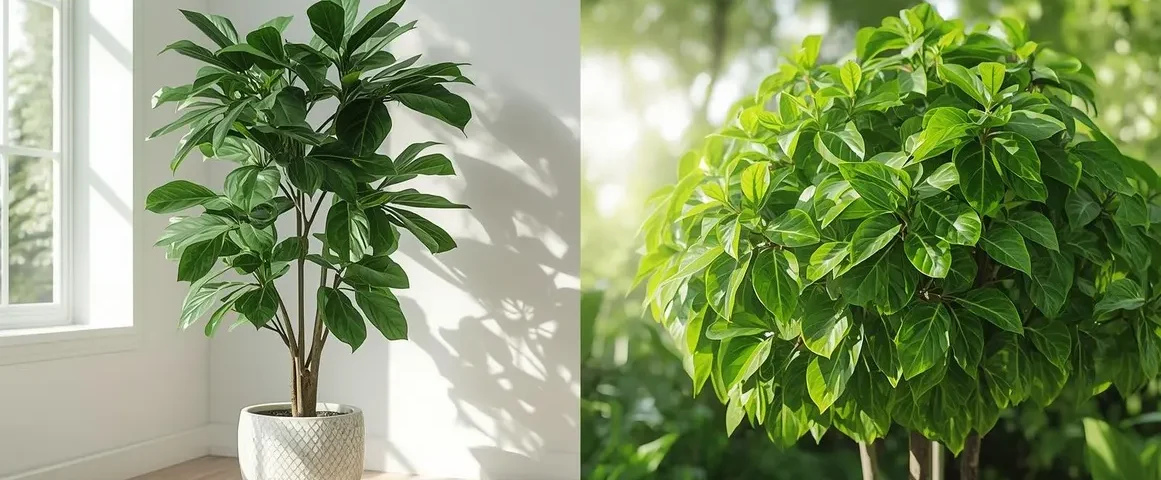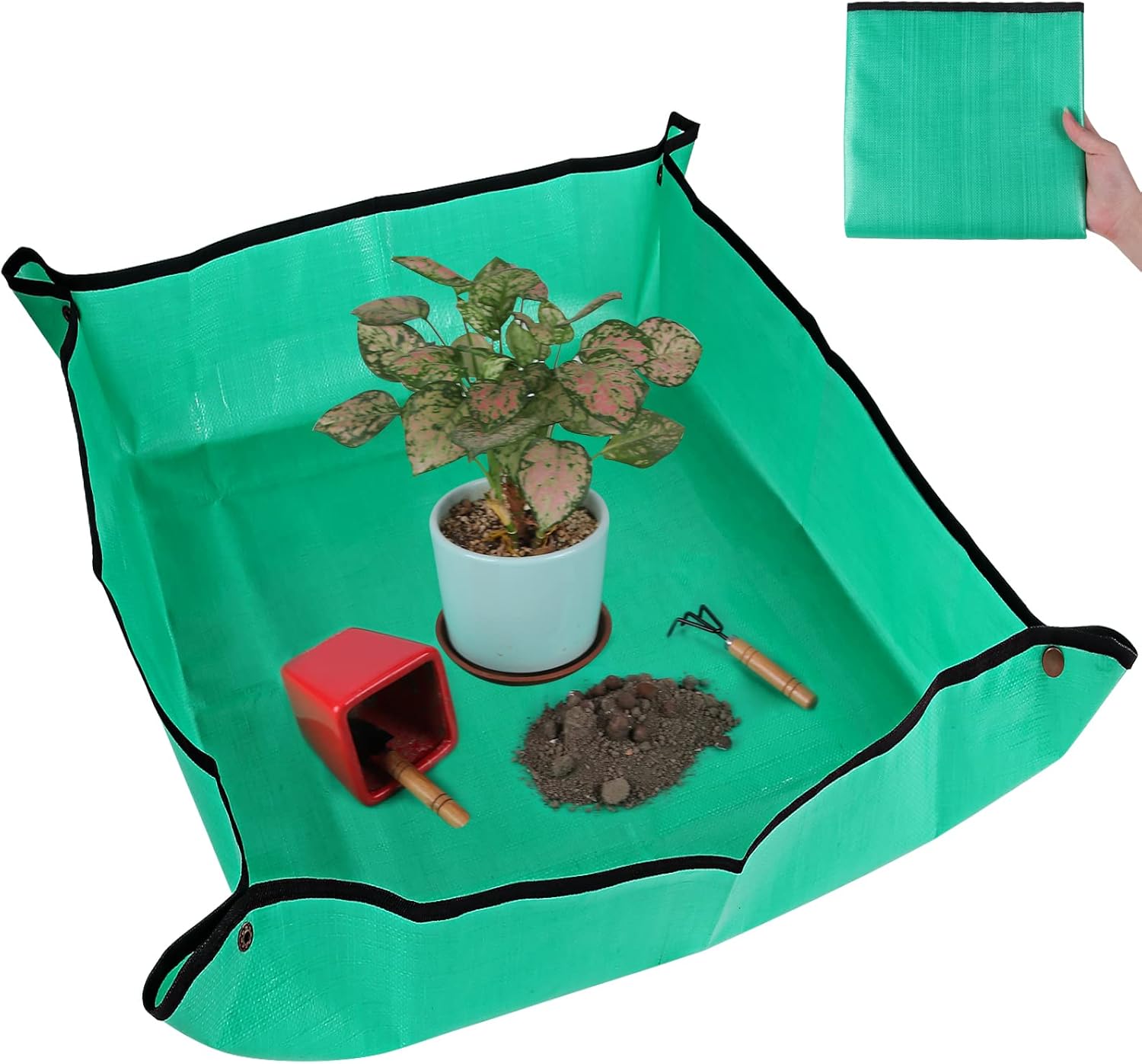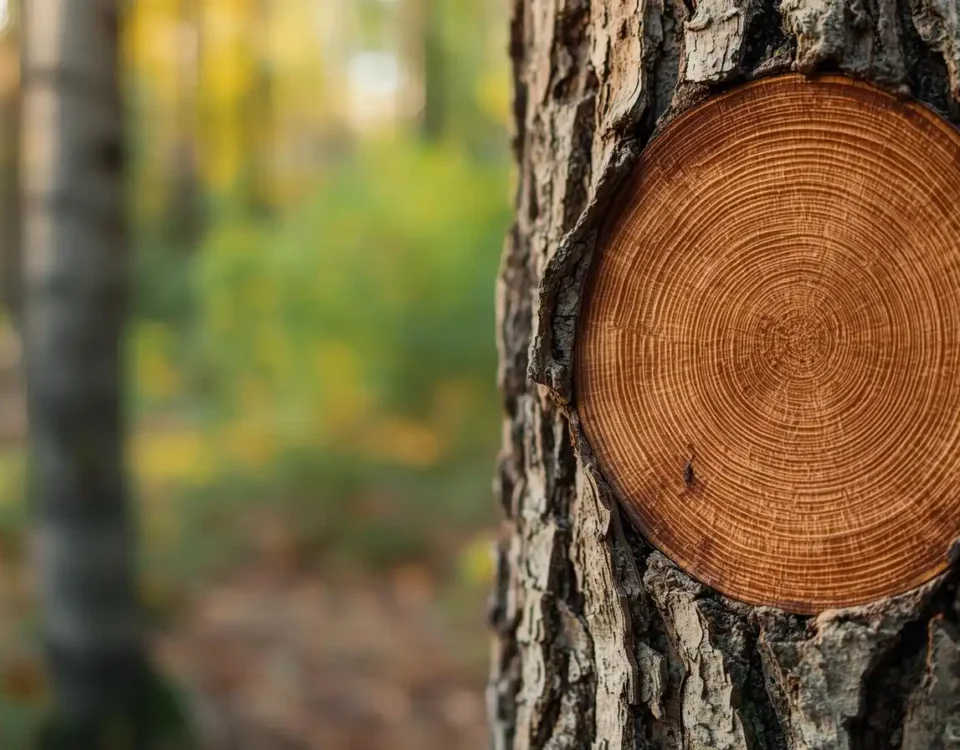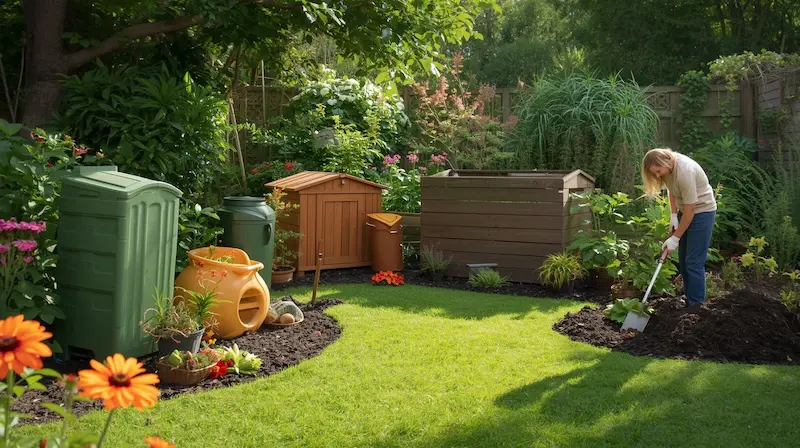
Transform Your Garden: The Ultimate Guide to Attracting Birds with Native Plants & Landscaping
October 25, 2025
Grow Your Own Climate Solution A Definitive Guide to Fast-Growing Trees for Ultimate Cooling & Green Living
October 26, 2025Few houseplants command attention quite like the Ficus family. From the dramatic Fiddle Leaf Fig with its sculptural leaves to the graceful Weeping Fig that adds elegance to any corner, these trees have become icons of lush indoor living. Yet, for all their beauty, Ficus plants are notorious for testing patience. One day, they’re thriving, and the next, leaves are dropping without warning or curling in quiet protest. It’s no wonder many plant enthusiasts call them the divas of the indoor jungle.
If you’ve ever found yourself staring at yellowing leaves, stunted growth, or an unexplained pest invasion, you’re not alone. Many Ficus owners struggle to strike the balance between too much care and not enough. But here’s the good news: once you understand their quirks, Ficus trees reward you with years of vibrant growth and natural beauty. This guide will walk you through that transformation, turning confusion into clarity and frustration into satisfaction.
Written by experienced horticulturists, this guide combines years of practical know-how with proven, science-based insights. Whether you’re nurturing your first plant or refining your indoor garden, the advice you’ll find here is grounded in real expertise and tested techniques.
Get ready to explore everything you need to become a confident Ficus caretaker, from choosing the right species and perfecting your watering routine to advanced propagation and solving the toughest plant problems. By the end, you’ll have the tools to help your Ficus not just survive but truly thrive for years to come.
Understanding Your Ficus: A World of Green Diversity
Introduction to Ficus Trees
The Ficus Phenomenon
Ficus trees have a long and fascinating history as houseplants. Originating from tropical and subtropical regions, these members of the Moraceae family have been cultivated for centuries, both for their beauty and symbolic significance. In many cultures, the Ficus is seen as a tree of wisdom, longevity, and prosperity. Over time, they’ve made their way indoors, gracing homes, offices, and studios around the world. Today, they’re among the most popular indoor plants, prized for their striking foliage and ability to adapt to a variety of environments.
Beyond aesthetics, Ficus trees are more than just pretty faces, promoting green living. They actively improve indoor air quality by filtering common pollutants, adding freshness and life to enclosed spaces. Whether it’s a bold statement piece in the living room or a calming presence in a workspace, their lush greenery brings balance and serenity to modern interiors. The Ficus genus itself is impressively diverse, encompassing over 800 species, from creeping vines that hug walls to towering trees that command attention, each with unique tree bark.
The Appeal of Ficus
What makes Ficus trees so captivating is their ability to blend beauty with wellness. Their presence softens hard edges, adds organic texture, and introduces a calming natural rhythm to any room. Interior designers often use them to anchor open spaces or complement minimalistic styles with a touch of vibrant life.
From a wellness perspective, Ficus plants play a subtle yet powerful role. Studies have shown that the presence of greenery indoors can reduce stress, improve mood, and even boost productivity. Integrating Ficus varieties into your home isn’t just about decoration; it’s about creating an environment that supports emotional and physical well-being.
For example, a Fiddle Leaf Fig (Ficus lyrata) with its dramatic, sculptural leaves suits modern, airy interiors. In contrast, a Weeping Fig (Ficus benjamina), with its fine foliage and graceful form, enhances traditional or bohemian spaces. A compact Rubber Plant (Ficus elastica) or Audrey (Ficus benghalensis) fits perfectly in corners where you want a touch of green without overwhelming the room. Each variety offers a unique aesthetic and atmosphere, allowing you to match your plant to your personal style.
(Note: The Ficus genus belongs to the Moraceae family, which also includes mulberries and breadfruit, reflecting its deep botanical roots and scientific importance.)
Exploring Popular Ficus Varieties
Each Ficus variety has its own personality, some bold and dramatic, others understated and easygoing. Understanding their differences will help you choose one that fits your space and lifestyle.
Fiddle Leaf Fig (Ficus lyrata)
Arguably the most famous of them all, the Fiddle Leaf Fig is loved for its broad, violin-shaped leaves and sculptural presence. It’s perfect as a statement plant but comes with a reputation for fussiness. It needs bright, indirect light and consistent care, reacting quickly to overwatering or sudden changes in the environment. When happy, it can grow several feet tall, transforming a corner into a focal point of lush greenery.
Rubber Plant (Ficus elastica)
The Rubber Plant is a sturdy and forgiving option. Its thick, glossy leaves come in several striking varieties: deep burgundy, creamy variegated Tineke, or pink-tinged Ruby. It tolerates a bit of neglect, making it ideal for busy households or offices. Wiping its large leaves occasionally keeps them glossy and dust-free.
Weeping Fig (Ficus benjamina)
The Weeping Fig is known for its elegant, arching branches and dense foliage. It’s often grown as a small indoor tree with braided trunks, lending a refined, tropical charm to any space. However, it’s sensitive to changes in light, drafts, and movement, conditions that often lead to leaf drop. Once it acclimates, though, it becomes a reliable and graceful addition to your plant collection.
Audrey (Ficus benghalensis)
The Audrey, a close cousin of the Banyan tree, is becoming a favorite among modern plant enthusiasts. Its soft, velvety leaves and lighter green hue give it a fresh, contemporary appeal. Unlike the Fiddle Leaf Fig, it’s more forgiving of irregular care, making it suitable for those who love the look of a tree-form Ficus but prefer less drama.
Bonsai Ficus (Various species, commonly Ficus retusa)
For those drawn to the art of bonsai, the Ficus family offers some of the best beginner-friendly options. Compact and sculptural, the Bonsai Ficus thrives under regular pruning and shaping. It prefers bright, indirect light and consistent watering, with the top layer of soil kept slightly moist. Its twisted roots and miniature canopy make it a living piece of art that invites mindfulness and creativity.
Other Notable Mentions
- Creeping Fig (Ficus pumila): A fast-growing vine that clings to surfaces, great for vertical gardens or terrariums.
- Ginseng Ficus (Ficus micro carpa): Recognized for its thick, root-like trunk and glossy leaves, often styled as a bonsai.
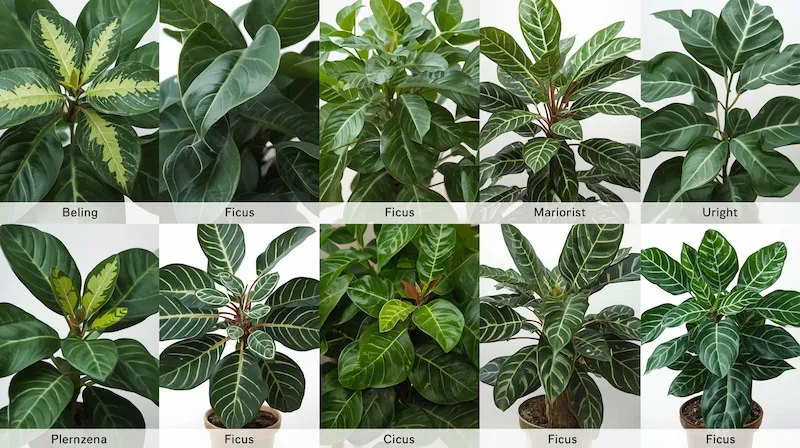
Ficus Variety Comparison Table
|
Variety Name |
Scientific Name |
Light Preference |
Watering Frequency |
Humidity Needs |
Mature Size (Indoor) |
Growth Habit |
Special Care Notes |
|
Fiddle Leaf Fig |
Ficus lyrata |
Bright, indirect; some gentle morning sun |
Moderate (let top 2–3" dry) |
High |
6–10 ft |
Upright, tree-like |
Sensitive to change; prone to leaf drop if overwatered or moved. |
|
Rubber Plant |
Ficus elastica |
Bright, indirect |
Moderate (let top 1–2" dry) |
Moderate |
5–8 ft |
Upright, bushy |
Very hardy; clean leaves regularly for shine and health. |
|
Weeping Fig |
Ficus benjamina |
Bright, indirect |
Consistent (let top 1" dry) |
High |
4–7 ft |
Bushy, graceful, weeping |
Avoid moving once placed; dislikes drafts and temperature swings. |
|
Audrey |
Ficus benghalensis |
Bright, indirect |
Moderate (let the top 2" dry) |
Moderate |
5–8 ft |
Upright, tree-like |
More tolerant than lyrata; prefers steady conditions. |
|
Bonsai Ficus |
Ficus retusa |
Bright, indirect; some gentle direct light |
Frequent; monitor moisture closely |
Moderate–High |
1–3 ft |
Shaped, miniature tree |
Requires regular pruning and care |
The Pillars of Ficus Health: Core Environmental Needs
Keeping a Ficus healthy isn’t about luck; it’s about balance. These tropical plants thrive when their key environmental needs are met. Light, water, humidity, soil, and nutrients work together like the five pillars of plant wellness. Understanding each one will help your Ficus grow strong, resilient, and beautiful.
Light Requirements: The Foundation of Ficus Health
Understanding Light Intensity
Light is the single most important factor in keeping a Ficus happy. The challenge is finding the right kind.
- Direct vs. Indirect Light: Direct light means sunbeams touch the leaves for several hours a day. Indirect light is bright but filtered, ideal for most Ficus species. Place your plant near a south- or east-facing window where it receives plenty of ambient light without harsh rays. West windows can also work, though you might need a sheer curtain to soften the afternoon sun.
- Optimal Placement: In most homes, a bright living room corner or beside a window with sheer curtains provides the perfect balance.
- Light’s Role in Growth: Adequate light encourages vibrant leaf color, strong stems, and steady growth. Too little light, and your Ficus will lose its rich color and stretch out in search of the sun.
Signs of Too Much or Too Little Light
- Too Little Light: You’ll notice leggy growth, smaller leaves, dull coloration, and gradual leaf drop.
- Too Much Light: Leaves may develop scorched or bleached patches, crispy edges, or dry spots.
Seasonal Adjustments
In winter, shorter days and weaker sunlight can slow your plant’s growth. Move your Ficus closer to a bright window or supplement with a full-spectrum grow light. During summer, make sure it’s shielded from intense direct sun that can burn the leaves.
Expert Tip: Rotate your Ficus 90 degrees every week or two. This ensures even light exposure and helps prevent leaning or lopsided growth.

Watering Best Practices & Guide
The Golden Rule of Ficus Watering
Consistency is key, but the golden rule is simple: water only when your plant needs it.
- Checking Moisture: Use the finger test, insert your finger two to three inches into the soil. If it feels dry, it’s time to water. A soil moisture meter can give more accurate readings, especially for large pots.
- Frequency Cues: Ficus plants prefer moderately moist soil, not soggy or bone-dry.
Understanding Drainage Needs
Always use pots with drainage holes. When watering, do it thoroughly until water drains from the bottom, then empty the saucer to prevent the roots from sitting in water. Poor drainage is one of the leading causes of root rot.
Recognizing Signs of Over watering
- Yellowing or dropping leaves
- Mushy stems or roots
- A sour smell from the soil
If your Ficus shows these signs, check the roots. Trim away any soft, brown sections and repot in fresh, well-draining soil.
Recognizing Signs of Under watering
- Dry, crispy leaf edges
- Drooping or curling leaves
- Slowed or stunted growth
Expert Tip: Always check the top few inches of soil before watering. Over watering kills more Ficus trees than neglect ever will.
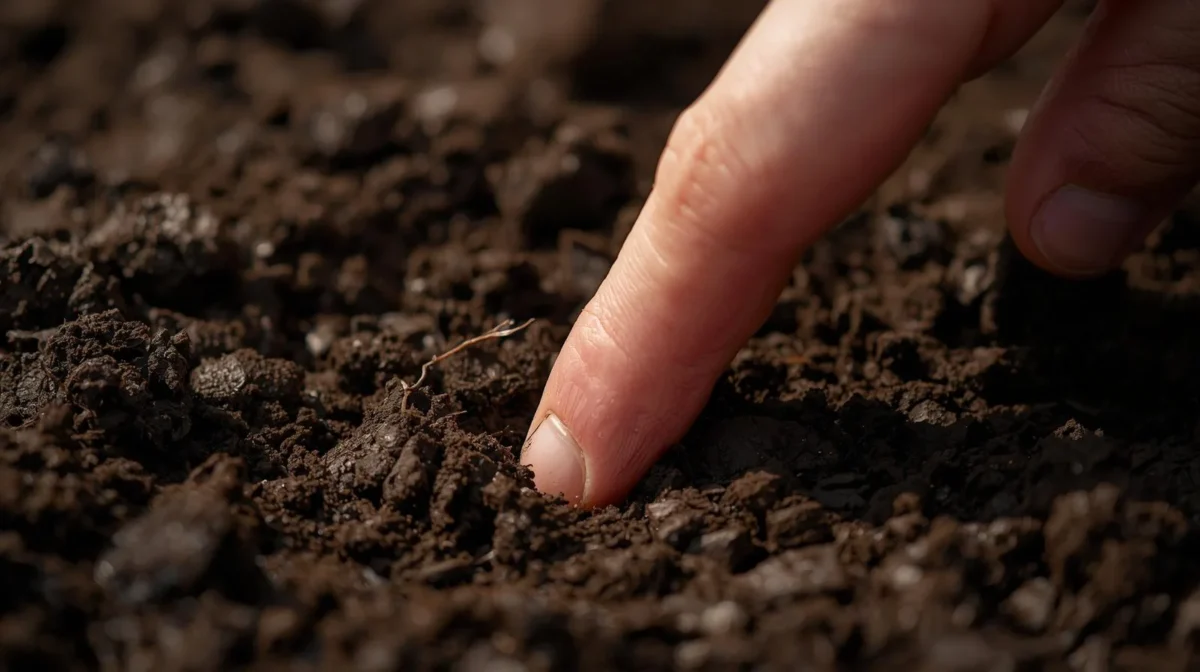
Humidity Needs & Solutions
Why Humidity is Crucial
Ficus trees evolved in tropical environments with naturally humid air. Indoors, especially during winter when heating systems run, air becomes dry, causing brown, crispy leaf edges and curling foliage.
Practical Methods to Increase Humidity
- Misting: Light misting can temporarily raise humidity, but it isn’t a long-term fix. Avoid misting at night or soaking the leaves.
- Pebble Trays: Place a layer of pebbles in a tray, fill it with water just below the pebble tops, and set your pot on top. As the water evaporates, it creates a humid microclimate around your plant.
- Humidifiers: The most effective option for consistent humidity. Choose a cool-mist model designed for houseplants.
- Grouping Plants: Positioning multiple plants together creates a shared humid zone as they release moisture through transpiration.
Product Recommendations: A humidifier or pebble tray can make a noticeable difference, especially in dry climates or during winter.
The HC Companies Flower Pot Saucers - Plastic Plant Saucer for Outdoors & Indoors
Durable & Lightweight: Built from weather-resistant plastic, these plant saucers are sturdy yet easy to move ideal for indoor and outdoor use.
Classic Design: The simple, natural look complements any décor, from modern patios to traditional gardens.
Perfect Size: Each saucer measures 8.5" x 8.5" x 1.5", offering reliable protection for most pots.
Made in the USA: Crafted by The HC Companies in Ohio—trusted for over 35 years in quality horticultural products.
Ficus Micro climate
To create an optimal indoor environment, maintain humidity between 50–60% and keep temperatures steady between 65–80°F (18–27°C). Avoid placing your Ficus near heating vents or cold drafts.
Expert Tip:
Maintaining humidity also deters spider mites, a common pest that thrives in dry air.
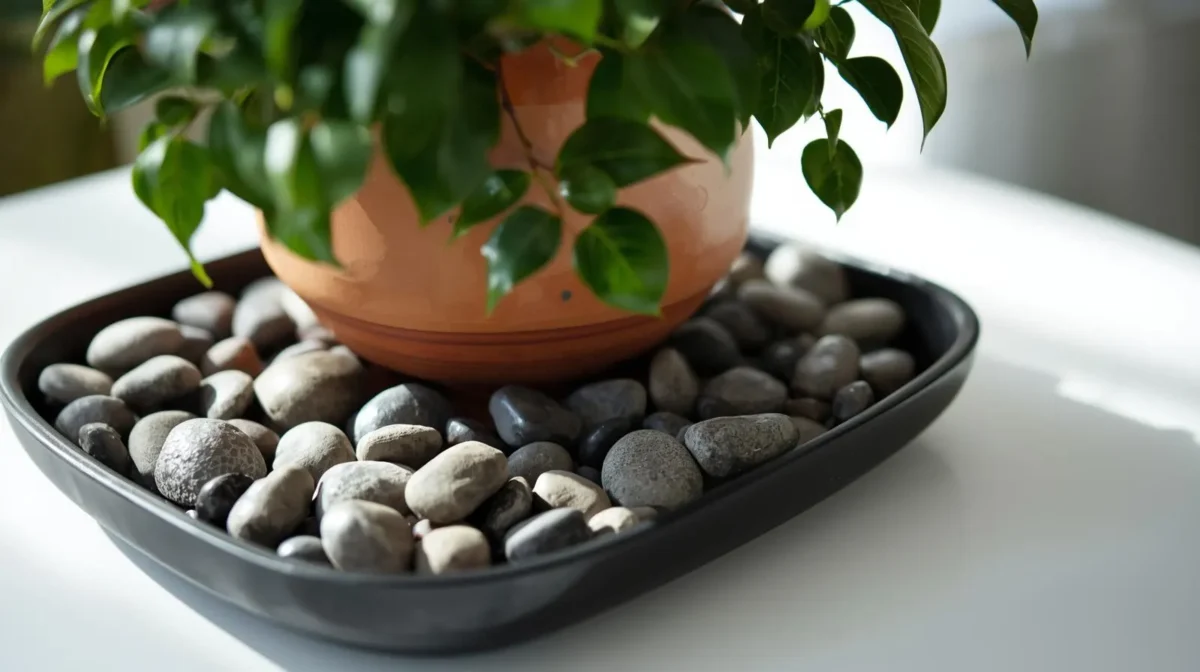
Soil & Potting: Creating the Right Environment
The Ideal Ficus Soil Mix
Ficus roots love oxygen and moisture, but not excess water. The ideal soil is well-draining yet moisture-retentive.
- Recommended Mix: Combine peat moss, perlite, pine bark, and coco coir for balance.
- Product Recommendation: Use a well-draining potting mix specifically designed for ficus or aroids.
Importance of Proper Drainage
Drainage holes are non-negotiable. Avoid placing gravel or broken pottery at the bottom of the pot, as it can trap water instead of improving drainage.
Choosing the Right Pot
When repotting, choose a pot only 1–2 inches larger in diameter than the old one. Oversized pots retain excess moisture and can suffocate roots.
- Terracotta: Breathable but dries quickly.
- Plastic: Lightweight and moisture-retaining.
- Ceramic: Stylish but heavier and less porous.
Step-by-Step Repotting Guide
- Check for root-bound signs (roots circling the pot or pushing through drainage holes).
- Gently remove the plant and loosen the roots.
- Place fresh soil at the base of the new pot.
- Position the plant, fill in the gaps, and water thoroughly.
Expert Tips:
- Repot only when necessary, usually every 1–2 years in spring.
- Handle carefully: Ficus sap is milky and can irritate the skin. Always wear gardening gloves and protect your surfaces.
Azureblue Plant Repotting Mat for Indoor Plants Potting Soil Mix, Waterproof Plant Repotting Tray
-
Mess-Free Gardening: Keep soil and water contained while potting or repotting plants with this waterproof gardening mat no more dirty floors or tables.
-
Durable & Reusable: Made from thick, waterproof PE fabric with high snap-up corners to form secure walls that prevent spills.
-
Multi-Purpose Design: Ideal for indoor gardening, crafts, pet grooming, toy cleanup, or painting projects foldable and easy to store.
-
Perfect Gift for Plant Lovers: A thoughtful, practical gift for plant parents in apartments or small spaces.
-
Lifetime Guarantee: Backed by a 100% Money-Back or Replacement Warranty for complete customer satisfaction.
Fertilization Guide for Vigorous Growth
When and How Often to Fertilize
Ficus plants are active feeders during their growing season (spring and summer). Fertilize every 2–4 weeks with a balanced formula. Reduce or stop feeding in fall and winter when growth slows.
Types of Fertilizers to Use
- Balanced Liquid Fertilizer (e.g., 5-5-5 or 10-10-10 NPK): Ideal for regular feeding.
- Slow-Release Fertilizer: Convenient for consistent nutrition over several months.
- Organic Options: Fish emulsion or compost tea provides gentle, natural nourishment.
Product Recommendation: Use a balanced liquid houseplant fertilizer and always dilute according to instructions.
Schultz All Purpose Liquid Plant Food 10-15-10, 8 oz
-
ll-Purpose Plant Food: Perfect for flowers, tomatoes, roses, vegetables, fruits, trees, shrubs, annuals, perennials, and houseplants supports vibrant growth and abundant blooms.
-
Versatile Use: Suitable for both indoor and outdoor plants, providing balanced nutrition for healthy root and foliage development.
-
Made in the USA: Reliable quality with a 14.6 oz package size easy to store and apply.
-
Model: SPF45170
Safety Information:
Keep out of reach of children and pets. Avoid contact with skin or eyes wear gloves when handling. Do not ingest. Store in a cool, dry location away from heat or flame. Dispose of responsibly. If contact or ingestion occurs, rinse thoroughly and seek medical attention immediately.
How to Fertilize Safely
Always apply fertilizer to moist soil to prevent root burn. Less is more; under-fertilizing is safer than overdoing it.
Recognizing Signs of Nutrient Deficiency
- Pale or yellowing leaves (chlorosis)
- Weak stems or slow growth
Recognizing Signs of Over-Fertilization
- Brown, crispy leaf edges
- White crust is forming on the soil surface.
- Damaged roots or wilting despite moist soil
Expert Tip: Only fertilize when your Ficus is actively growing. Overfeeding during dormancy can harm roots and throw off their natural rhythm.
Cultivating & Expanding Your Ficus Collection
Once your Ficus is thriving, the next step is refinement and expansion. Pruning keeps your plant looking its best and encourages healthy new growth, while propagation lets you multiply your collection or share it with others. With a little knowledge and care, both practices can be rewarding parts of your indoor gardening routine.
Pruning Techniques for Shape & Health
Why Prune Your Ficus
Pruning isn’t just about aesthetics; it’s essential for long-term health.
- Shape and Size Control: Regular trimming helps maintain the desired form and prevents your Ficus from outgrowing its space.
- Encouraging Bushier Growth: Cutting back leggy stems promotes branching, giving the plant a fuller, more balanced appearance.
- Removing Damaged Growth: Pruning away dead or diseased branches prevents problems from spreading and improves overall vitality.
- Air Circulation: Thinning dense areas allows air and light to reach inner leaves, reducing the risk of fungal issues.
Essential Tools & Safety Precautions
You’ll need quality pruning shears or bypass pruners for clean, precise cuts. Dull tools can crush stems and invite infection.
- Sterilize Before Use: Wipe blades with rubbing alcohol before and after pruning to prevent disease transmission.
- Wear Gloves: Ficus sap is milky and sticky. It can irritate the skin, so gloves are a must.
Step-by-Step Pruning Guide
- Identify the Targets: Look for leggy, crossing, or unhealthy branches.
- Locate the Node: Always cut just above a node (the small bump where a leaf or new branch emerges).
- Use Clean Cuts: Make a sharp, angled cut to prevent moisture buildup and promote healing.
- Shape Thoughtfully:
- For height control, trim the tallest stems evenly to maintain a uniform silhouette.
- For width or fullness, cut back to encourage side branching and density.
- For height control, trim the tallest stems evenly to maintain a uniform silhouette.
Advanced Ficus Training & Shaping Techniques
Once you’re confident with basic pruning, you can explore more advanced methods:
- Wiring: Used in Bonsai Ficus shaping, wiring involves gently bending branches into artistic forms. Use flexible bonsai wire and avoid wrapping too tightly.
- Topiary Techniques: With patience, Ficus species can be trained into decorative forms, spirals, spheres, or braided trunks.
- Controlled Pruning: Strategic trimming helps maintain specific designs without stressing the plant.
Expert Tip: Don’t hesitate to prune. It’s one of the best ways to keep your Ficus healthy and attractive. Just remember, clean tools, measured cuts, and confidence make all the difference.
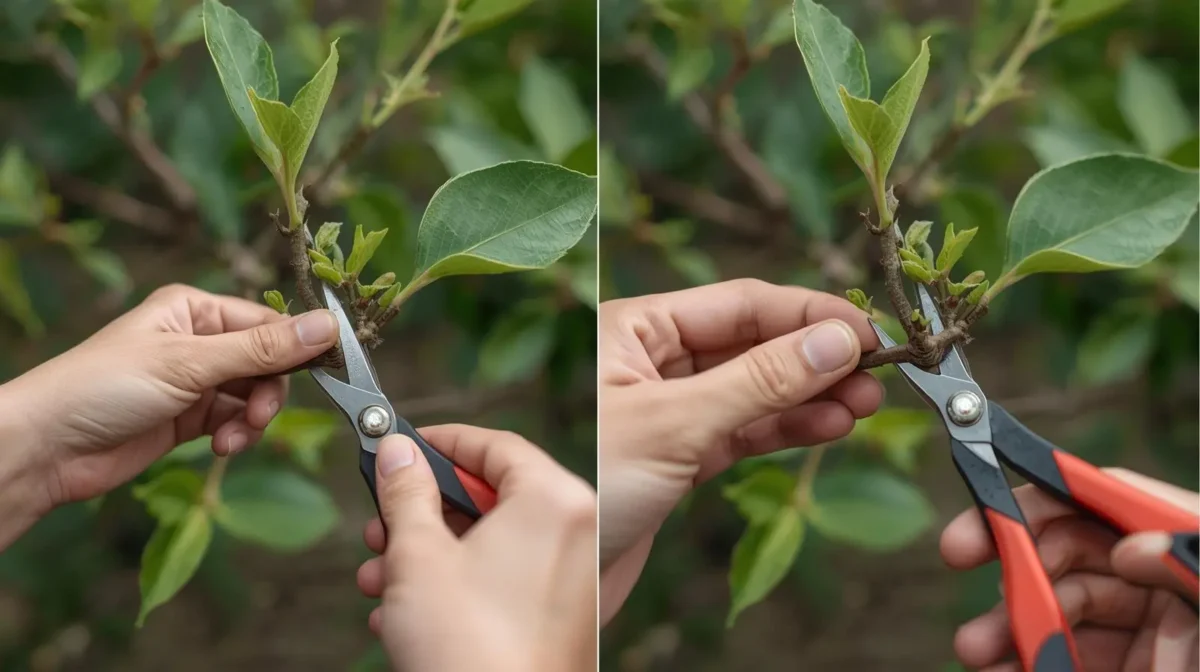
Propagation Methods: Growing Your Ficus Collection
Understanding Ficus Propagation
Propagation allows you to grow new plants from your existing Ficus. It’s cost-effective, satisfying, and a great way to share your love of plants with friends. You can also use it to rescue a struggling plant by rooting healthy cuttings.
Stem Cuttings: The Most Common Method
- Select the Right Cutting: Choose a healthy stem, 4–6 inches long, with 2–3 leaves. Avoid soft or woody stems.
- Prepare the Cutting: Remove the bottom leaves, leaving one or two at the top. Optionally dip the cut end in rooting hormone to encourage faster root growth.
- Rooting in Water:
- Place the cutting in a clean glass of room-temperature water.
- Change the water every 2–3 days to prevent bacteria buildup.
- Keep it in bright, indirect light.
- Once roots reach about 2 inches long, transfer the cutting to a small pot with moist, well-draining soil.
- Place the cutting in a clean glass of room-temperature water.
- Rooting in Soil:
- Use a light mix of perlite, peat, and coco coir.
- Insert the cutting about 2 inches deep.
- Cover it with a humidity dome or clear plastic bag to maintain moisture until roots form (usually within 4–6 weeks).
- Use a light mix of perlite, peat, and coco coir.
Leaf Cuttings (for Some Varieties Like Rubber Plant)
Certain species, like Ficus elastica, can grow from leaf cuttings with a small section of stem attached.
- Cut a healthy leaf with about an inch of stem.
- Dip in rooting hormone.
- Place the stem in moist soil and cover it to retain humidity.
- Keep it warm and well-lit, and new roots should begin to develop within a month or two.
Environmental Conditions for Success
Ficus cuttings root best in warm, humid environments with steady temperatures (70–80°F or 21–27°C). Keep them out of direct sunlight but ensure plenty of ambient light.
Troubleshooting Propagation Issues
- No Roots: The cutting might not have enough light or warmth. Try adding a heat mat or using a rooting hormone.
- Rotting: Overwatering or stagnant water can lead to rot. Refresh water or reduce soil moisture.
- Wilting: Low humidity or too much sun may stress young cuttings; cover them lightly to retain moisture.
Expert Tip: Patience pays off. Rooting can take several weeks, but once established, new Ficus plants grow quickly with proper care.
Keeping Your Ficus Healthy: Troubleshooting & Prevention
Even with the best care, every Ficus owner eventually faces a few bumps along the way. Sudden leaf drop, yellowing leaves, or sticky residue can leave even experienced plant lovers puzzled. That’s why this section acts as your go-to diagnostic tool, helping you quickly identify what’s going wrong and guiding you toward the right fix.
Interactive Ficus Health Checklist
Think of this checklist as a quick, interactive health check for your Ficus. Each question points you to the most likely cause and where to find the solution within this guide.
|
Symptom |
Possible Cause |
Where to Look for Solutions |
|
Leaves dropping suddenly? |
Sudden environmental change (drafts, relocation, overwatering, or shock). |
See “Light & Environment” and “Watering Consistency.” |
|
Leaves turning yellow, especially lower ones? |
Overwatering or nutrient deficiency. |
Go to “Watering & Fertilization.” |
|
Crispy brown edges on leaves? |
Low humidity or excessive direct sunlight. |
Go to “Humidity & Light Balance.” |
|
Sticky residue on leaves or nearby surfaces? |
Sap-sucking pests such as scale or mealybugs. |
See “Pest Management & Treatment.” |
|
Small webs or tiny dots under leaves? |
Spider mites. |
Go to “Pest Management & Treatment.” |
|
New leaves very small or growth stunted? |
Nutrient imbalance or root-bound conditions. |
See “Fertilization & Repotting.” |
|
Plant leaning heavily toward a window? |
Insufficient light or uneven exposure. |
Go to “Light Requirements & Rotation.” |
|
Leaves curling inward or downward? |
Temperature stress or inconsistent watering. |
See “Temperature & Moisture Management.” |
|
Brown spots on leaves? |
Fungal infection or bacterial leaf spot. |
Go to “Fungal & Bacterial Issues.” |
|
White residue on the soil surface? |
Mineral build-up or overfertilization. |
See “Soil Health & Water Quality.” |
How to Use This Checklist
- Start with Observation: Look at your Ficus closely, both leaves and soil.
- Match the Symptom: Use the checklist to find the issue that best describes what you see.
- Follow the Trail: Each problem links to a core care area, light, water, nutrients, or pests, so you can take targeted action.
- Track Progress: After making adjustments, monitor your plant for 1–2 weeks before changing anything else.
Pro Tip: Prevention Is the Best Cure
Most Ficus issues stem from inconsistency in watering, light exposure, or environment. Create a simple routine:
- Rotate your Ficus weekly for even light exposure.
- Water only when the top 2 inches of soil feel dry.
- Wipe leaves monthly to remove dust and inspect for pests.
- Use a humidifier or pebble tray if indoor air is dry.
Healthy habits go a long way toward preventing the sudden leaf drop or discoloration that frustrates so many plant owners.
Visual Suggestion
- Infographic: “Ficus Problem Solver” – a flowchart showing symptom → cause → solution.
- Example:
“Yellow leaves → Check soil moisture → Too wet? Reduce watering → Too dry? Adjust schedule.” - Design Tip: Use color-coded arrows (green for healthy, red for warning) to make it easy to follow.
Ficus Photo Guide: What’s Wrong With My Plant?
Caring for a Ficus is a rewarding experience, but even the most attentive plant owners can run into trouble. This photo-based guide helps you visually identify what’s wrong with your Ficus and connect it directly to the solution. Each issue is illustrated with high-quality, close-up images, so you can spot problems early and act fast.
Common Ficus Problems and Visual Diagnoses
- Yellowing Leaves
- What It Looks Like: Lower leaves fading to yellow before dropping.
- Possible Causes: Overwatering, underwatering, or nutrient deficiency.
- Quick Fix: Check soil moisture. If it’s soggy, reduce watering and improve drainage. If dry, water thoroughly. Fertilize monthly during active growth.
- Learn More: See “Watering & Fertilization.”
- Visual Suggestion: Side-by-side photo showing overwatered vs. underwatered yellowing leaves.
- Brown, Crispy Leaf Edges
- What It Looks Like: Dry, curling, or crisp edges along the leaves.
- Possible Causes: Low humidity, underwatering, or too much direct sunlight.
- Quick Fix: Increase humidity with a pebble tray or humidifier and move away from harsh light.
- Learn More: See “Humidity & Light Balance.”
- Visual Suggestion: Close-up of leaf with dry, browned edges labeled “Low Humidity Damage.”
- Sudden Leaf Drop
- What It Looks Like: Multiple leaves falling within days, often still green.
- Possible Causes: Shock from relocation, temperature changes, or inconsistent watering.
- Quick Fix: Keep the plant’s environment stable. Avoid moving or overwatering it for at least two weeks.
- Learn More: See “Environmental Stability & Shock Prevention.”
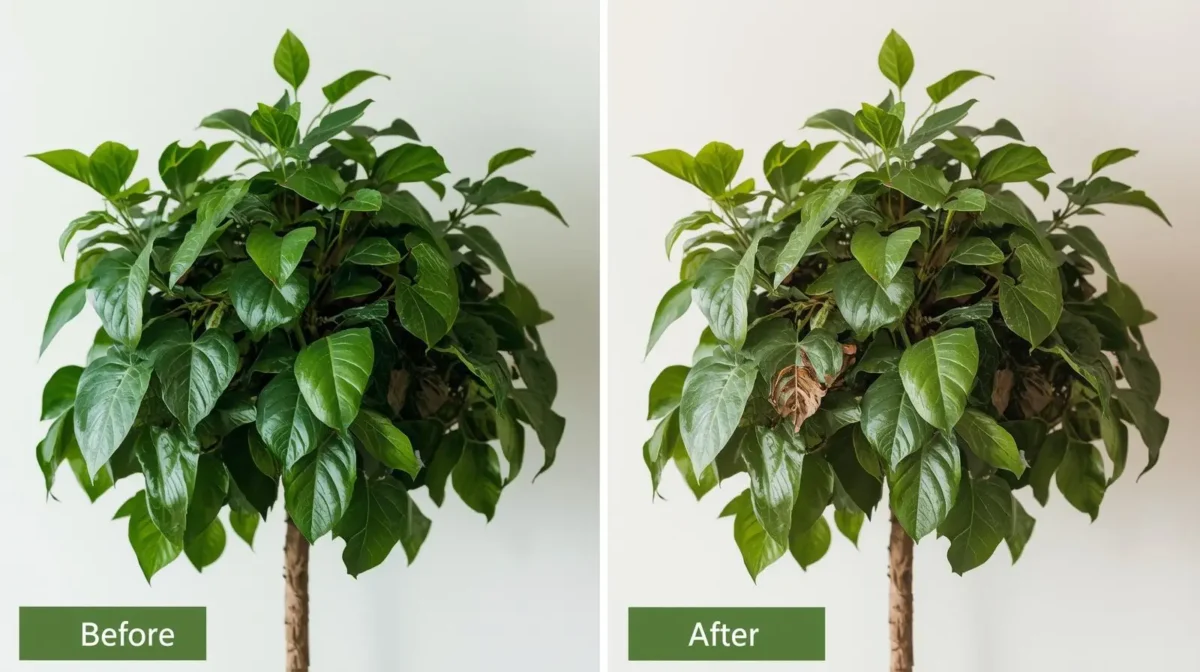
- Stunted or Small Leaves
- What It Looks Like: New leaves emerging noticeably smaller or fewer in number.
- Possible Causes: Lack of light, poor nutrition, or root-bound conditions.
- Quick Fix: Move closer to bright, indirect light and feed with a balanced fertilizer. Repot if roots are circling the pot.
- Learn More: See “Light Requirements & Repotting.”
- Visual Suggestion: Photo comparing healthy new growth vs. stunted growth.
- Leaf Spots
- What It Looks Like: Brown, black, or yellow blotches appearing irregularly on leaves.
- Possible Causes: Fungal or bacterial infection, often from overwatering or poor air circulation.
- Quick Fix: Remove affected leaves and improve airflow. Use a mild fungicide if the issue persists.
- Learn More: See “Fungal & Bacterial Issues.”
- Visual Suggestion: Macro shot of a Ficus leaf with clear fungal spotting patterns.
- Pest Damage
- What It Looks Like: Tiny webs, sticky residue, distorted leaves, or visible insects.
- Common Culprits: Spider mites, mealybugs, scale, and thrips.
- Quick Fix: Wipe leaves with neem oil or insecticidal soap. Isolate the plant until pests are gone.
- Learn More: See “Pest Management & Treatment.”
- Visual Suggestion: Close-up collage of each pest type labeled for clarity.
- Root Rot
- What It Looks Like: Mushy, blackened roots and a foul smell from the soil.
- Possible Causes: Chronic overwatering or poor drainage.
- Quick Fix: Trim away damaged roots and repot in fresh, well-draining soil.
- Learn More: See “Root Health & Repotting.”
- Visual Suggestion: Cross-section photo of healthy (white) vs. rotten (dark, mushy) roots.
Pest & Disease Management
Even a healthy Ficus can attract pests or develop diseases if conditions aren’t ideal. Early detection and consistent care are key to keeping your plant pest-free.
Common Ficus Pests
|
Pest |
Symptoms |
Treatment |
|
Spider Mites |
Fine webs, stippling, tiny white or red dots on leaves. |
Wipe with neem oil; maintain higher humidity. |
|
Mealybugs |
White, cottony clusters in leaf axils or stems. |
Remove with alcohol-dipped cotton swab; use insecticidal soap. |
|
Scale Insects |
Hard, brown bumps along stems and leaf undersides. |
Scrape gently; apply horticultural oil or neem oil. |
|
Thrips |
Silvery streaks or distorted leaves, especially on new growth. |
Use sticky traps; prune damaged areas; apply organic insecticide. |
|
Fungus Gnats |
Small flying insects hover near the soil. |
Let the soil dry between waterings; use sticky traps or soil covers. |
Visual Suggestion: A labeled photo series of each pest on a Ficus leaf for quick recognition.
Prevention Strategies
- Inspect regularly: Check leaf undersides weekly.
- Quarantine new plants: Keep new additions separate for 2–3 weeks.
- Clean routinely: Wipe leaves to remove dust and pests.
- Improve airflow: Avoid overcrowding plants.
- Maintain balance: Proper watering and light help prevent infestations naturally.
Expert Tip: Always isolate newly purchased Ficus plants before placing them near your existing collection. Even seemingly healthy plants can carry hidden pests.
Treatment Options
- Organic Methods: Neem oil, insecticidal soap, and horticultural oils are effective and safe for regular use.
- Chemical Control: Only use systemic insecticides if infestations persist, following safety guidelines carefully.
- Product Recommendation: Neem Oil or Organic Insecticidal Soap for gentle yet effective results.
Troubleshooting Common Ficus Problems
Even a struggling Ficus can bounce back with the right care. Below are the most frequent issues and how to fix them effectively:
Sudden Leaf Drop
- Causes: Environmental shock, watering inconsistency, or pests.
- Solutions: Keep the plant stable, avoid sudden changes, and inspect for pests.
- Expert Tip: Acclimate your Ficus gradually when moving locations to prevent shock.
Yellowing Leaves
- Causes: Overwatering, nutrient deficiency, or natural aging.
- Solutions: Adjust watering schedule, fertilize monthly, and remove only the oldest yellow leaves.
Browning or Crispy Leaves
- Causes: Underwatering, low humidity, or too much sun.
- Solutions: Increase watering slightly, mist regularly, and move to indirect light.
Stunted Growth or Small Leaves
- Causes: Poor lighting, nutrient deficiency, root crowding, or pests.
- Solutions: Boost light exposure, fertilize, repot, and inspect for insects.
Expert Tip: Your Ficus “talks” through its leaves. Yellowing means too much water, brown tips mean not enough, and leaf drop signals stress.
Seasonal Care Adjustments
Your Ficus doesn’t have the same needs year-round. Adjust your routine to match its natural growth cycle.
Spring & Summer (Active Growth)
- Water more frequently as the soil dries faster.
- Fertilize every 4–6 weeks with a balanced formula.
- Prune to shape and encourage healthy branching.
- Ensure plenty of bright, indirect light.
Fall & Winter (Resting Season)
- Water less frequently, allow the top 2–3 inches to dry out.
- Stop or reduce fertilization until spring.
- Watch humidity levels indoors, especially near heating sources.
- Protect from cold drafts and temperature fluctuations.
Differentiation Opportunity:
Offer a Printable Ficus Care Calendar, a month-by-month checklist highlighting watering, fertilization, and pruning reminders. It helps readers stay consistent and track seasonal changes.
Visual Suggestion: Infographic illustrating seasonal Ficus care, half the chart labeled “Active Season” (bright colors, sun icons) and half “Resting Season” (cool tones, snowflake icons).
Advanced Ficus Care & Beyond
Once you’ve mastered the basics of watering, light, and humidity, you can take your Ficus care to the next level. This section dives into creating the perfect indoor ecosystem, exploring advanced propagation and maintenance techniques, and understanding how your Ficus can elevate both your home and your well-being.
Creating Your Ficus Microclimate
Ficus trees thrive when their environment mimics the conditions of their tropical origins: warm, humid, and gently breezy. While most homes don’t naturally replicate those settings, you can easily create a customized microclimate that supports consistent, healthy growth.
Optimizing Indoor Environment
- Grouping for Shared Humidity
Placing your Ficus near other houseplants naturally raises ambient humidity. Together, plants release moisture through transpiration, creating a stable, slightly more humid bubble of air. - Using Humidifiers Effectively
A quality humidifier can make a noticeable difference in leaf health and growth.
- Placement: Keep it 2–4 feet from your Ficus to avoid direct misting on leaves.
- Maintenance: Clean it weekly to prevent bacterial buildup.
- Optimal Setting: Aim for 50–60% relative humidity, especially in dry climates or heated homes.
- DIY Humidity Solutions
If you prefer a natural approach:
- Pebble Trays: Fill a tray with pebbles and water, placing the pot on top (not submerged).
- Terrariums or Glass Cloche Covers: Ideal for smaller Ficus species like Ficus pumila.
- Indoor Water Features: Small fountains or aquariums nearby can subtly raise humidity.
Temperature Considerations
Ficus trees prefer steady warmth:
- Ideal Range: 60–75°F (15–24°C).
- Avoid Extremes: Protect from cold drafts, heating vents, and sudden temperature drops.
- Pro Tip: A consistent environment is more important than the exact number. Sudden shifts stress the plant more than mild fluctuations.
Air Circulation
Still, stagnant air encourages fungal growth and pests.
- Solution: Use a small oscillating fan on a low setting to keep air moving gently.
- Placement Tip: Ensure the breeze brushes the leaves lightly without drying them out.
Expert Tip: A balanced environment, steady warmth, gentle airflow, and consistent humidity do more for long-term Ficus health than frequent watering or fertilizing ever will.
Expert Q&A: Addressing Ficus Myths & Advanced Topics
Even seasoned plant owners fall for a few common misconceptions. To clarify the facts, we consulted Dr. Elaine Turner, a horticultural scientist at the University of Florida, who specializes in tropical plant physiology.
Common Ficus Myths Debunked
Myth 1: “Ficus are impossible to keep alive.”
Truth: Ficus plants are sensitive to change, not fragile. Once they adjust to their environment, they’re surprisingly resilient.
Myth 2: “They need direct sunlight.”
Truth: Most Ficus varieties prefer bright, indirect light. Too much direct sun scorches their leaves, especially in smaller indoor spaces.
Myth 3: “You must water on a strict schedule.”
Truth: Watering depends on the environment and season. The top few inches of soil should dry out before the next watering; consistency matters more than timing.
Advanced Care Topics
- Root Pruning for Mature Plants
Over time, a well-established Ficus can outgrow its pot without needing a full repot. Root pruning helps keep size manageable and promotes new root growth.
- How-To: Remove the plant, trim about one-third of the outer roots, refresh the soil, and replant in the same pot.
- When: Every 2–3 years during spring or early summer.
- Air Layering for Larger Plants
This propagation method is ideal for large or leggy Ficus trees.
- Process: Select a healthy branch, make a small cut, wrap it in moist sphagnum moss, and cover with plastic wrap.
- Result: Roots form at the wound site; once established, the branch can be cut and potted as a new plant.
- Outdoor Ficus Care (for Warm Climates)
If your region stays above 60°F year-round, certain species, like Ficus benjamina, can live outdoors.
- Provide dappled shade to protect from intense midday sun.
- Ensure well-draining soil to avoid root rot from heavy rainfall.
This section references expert horticultural advice from Dr. Turner and verified plant physiology studies from university extension programs.
Integrating Ficus into Your Home: Design & Wellness
Ficus trees aren’t just decorative; they’re transformative. Their lush, structured forms add texture, color, and tranquility to interiors while improving indoor air quality and mental well-being.
Aesthetic Impact: Choosing the Right Variety
Each Ficus type complements different design styles:
- Fiddle Leaf Fig (Ficus lyrata): Ideal for minimalist or modern interiors; bold and sculptural.
- Weeping Fig (Ficus benjamina): Perfect for classic or formal rooms with soft, elegant lines.
- Rubber Plant (Ficus elastica): Works beautifully in bohemian, mid-century, or industrial spaces with its glossy leaves.
- Creeping Fig (Ficus pumila): Suited for vertical gardens or accent walls.
Pot Selection as a Design Element
- Terracotta: Natural and breathable; complements earthy interiors.
- Ceramic or Glazed Pots: Elegant finishes for modern or traditional homes.
- Woven or Rattan Covers: Great for casual or coastal-inspired spaces.
Placement Tips for Visual Impact
- Use height to your advantage; tall Ficus varieties can anchor corners or frame windows.
- Group with smaller plants for layered visual texture.
- Place mirrors or glass surfaces nearby to reflect their greenery and amplify light.
Wellness Benefits
- Air Purification
Studies by NASA and university plant researchers confirm that Ficus species help remove toxins such as formaldehyde and xylene, improving overall air quality indoors. - Biophilic Design & Stress Reduction
Integrating natural elements, like plants, into living spaces reduces stress and boosts productivity. A thriving Ficus becomes a living focal point that adds life and calm to your home. - The Joy of Nurturing
Caring for a Ficus cultivates mindfulness and patience. Watching new leaves unfurl or roots develop connects you to natural rhythms, even in urban settings.
Expert Tip: Your Ficus isn’t just décor, it’s a living, breathing companion that responds to attention and care. The small rituals of pruning, cleaning, and observing growth are what make plant care truly rewarding.
Frequently Asked Questions (FAQ)
Conclusion: Your Journey to Ficus Mastery
Caring for a Ficus isn’t about perfection; it’s about observation, patience, and consistency. When you understand the basics of light, watering, and humidity, you unlock the key to keeping your plant thriving year after year. Most Ficus challenges come down to balance: not too much water, not too little light, and a stable environment your plant can rely on.
The best Ficus caretakers learn to “listen” to their plants. Yellow leaves, brown tips, or slow growth aren’t failures; they’re messages. Each change is your plant’s way of showing what it needs. Once you start noticing these signs, you’ll find that maintaining a healthy Ficus becomes second nature.
This guide is built on research, expert insights, and proven care practices. We’re committed to keeping it accurate, updated, and practical, so it continues to serve as a reliable reference for plant lovers of all levels.
Now that you understand what your Ficus needs, take what you’ve learned and put it into action. Watch how small adjustments, better light, steady watering, and a bit more humidity transform your plant’s health and beauty. Caring for a Ficus isn’t just about growing a tree; it’s about nurturing life, patience, and connection.


